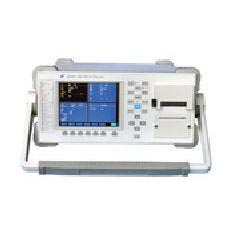
it is mainly used for comprehensive transmission test of SDH/PDH network and equipment and widely applied in the R&D, manufacture, acceptance inspection, performance monitoring, maintenance and measuring of networks and equipment. The instrument can insert and measure varieties of errors and alarms
| Signal Rate( f) | Balanced at f/2 |
| 2.048Mb/s | 6dBm |
| 8.448Mb/s | 6dBm |
| 34.368Mb/s | 12dBm |
| 139.264Mb/s | 12dBm |
| Error Type | Single | Ratio 10 -N |
| Frame | √ | |
| B 1 | √ | 5~9 |
| B 2 | √ | 3~9 |
| B 3 | √ | 4~9 |
| MS-REI | √ | 4~9 |
| HP-REI | √ | 4~9 |
| HP-IEC | √ | 4~9 |
| TU-BIP(block) | All Errors | |
| LP-REI | All Errors |

| Signal Type | Transmission Range | W(UI) |
| PDH signal | 1UI | 0.07 |
| 10UI | 0.26 | |
| SDH signal | 1UI | 0.15 |
| 10UI | 0.34 | |
| 20UI | 0.68 | |
| 50UI | 1.4 | |
| 200UI | 6.0 | |
| 400UI | 12.5 |
| Signal Rate | Modulation Frequency | Q |
| 2.048MHz | 20Hz-100kHz | 8 |
| 8.448MHz | 20Hz-400kHz | 8 |
| 34.368MHz | 100Hz-500kHz | 8 |
| 500kHz-800kHz | 12 | |
| 139.264MHz | 200Hz-500kHz | 8 |
| 500kHz-2MHz | 12 | |
| 2MHz-3.5MHz | 15 | |
| 155.520MHz | 500Hz-500kHz | 8 |
| 500kHz-1.3MHz | 12 | |
| 622.080MHz | 1kHz-500kHz | 8 |
| 500kHz-2MHz | 12 | |
| 2MHz-5MHz | 15 | |
| 2488.320MHz | 5kHz-500kHz | 8 |
| 500kHz-2MHz | 12 | |
| 2MHz-20MHz | 15 |
| Signal Rate | Measurement Range | W(UI) |
| 2.048MHz | 1.6UI | 0.08 |
| 16UI | 0.28 | |
| 8.448MHz | 1.6UI | 0.08 |
| 16UI | 0.28 | |
| 34.368MHz | 1.6UI | 0.08 |
| 16UI | 0.28 | |
| 139.264MHz | 1.6UI | 0.08 |
| 16UI | 0.36 | |
| STM-1 | 1.6UI | 0.08 |
| 16UI | 0.36 | |
| STM-4 | 1.6UI | 0.12 |
| 16UI | 0.50 | |
| STM-16 | 1.6UI | 0.24 |
| 32UI | 4.8 |
| Signal Rate | Jitter Modulation Frequency | R |
| 2.048MHz | 20Hz—100kHz | 7 |
| 8.448MHz | 20Hz—300kHz | 7 |
| 300kHz—400kHz | 8 | |
| 34.368MHz | 100Hz—300kHz | 7 |
| 300kHz—800kHz | 8 | |
| 139.264MHz | 200Hz—300kHz | 7 |
| 300kHz—1MHz | 8 | |
| 1MHz—3MHz | 10 | |
| 3MHz—3.5MHz | 15 | |
| STM-1 | 500Hz—300kHz | 7 |
| 300kHz—1MHz | 8 | |
| 1MHz—1.3MHz | 10 | |
| STM-4 | 1kHz—300kHz | 7 |
| 300kHz—1MHz | 8 | |
| 1MHz—3MHz | 10 | |
| 3MHz—5MHz | 15 | |
| STM-16 | 5kHz—300kHz | 7 |
| 300kHz—1MHz | 8 | |
| 1MHz—3MHz | 10 | |
| 3MHz—10MHz | 15 | |
| 10MHz—20MHz | 20 |
